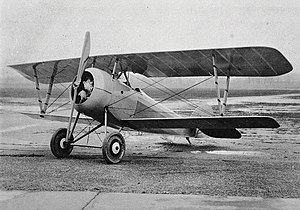Nieuport 27
| Nieuport 27 | |
|---|---|

| |
| Role | Fighter |
| Manufacturer | Nieuport |
| Primary users | |
| Developed from | Nieuport 24 |
| Wingspan | 8.18 m (26 ft 10 in) [1][2][3] |
| Engine | 130hp Le Rhône 9JB rotary |
| Armament | sync. fixed Vickers and/or top-wing Lewis |
| Crew | 1 |
| Max Speed | 172 km/h (107 mph) [4] to 185 km/h (115 mph)[3] to 186 km/h (116 mph)[5][2] |
| Climb | 2,000 m (6,560 ft) in 5:40[4] 3,000 m (9,840 ft) in 9:25[4] 4,000 m (13,100 ft) in 14:40[4] |
| Service Ceiling | 5,550 m (18,200 ft)[5][1][3] |
| Ceiling | 5,550 m (18,200 ft)[2] to 6,850 m (22,500 ft) [4] |
| Range | 250 km (160 mi)[4][3] |
| Endurance | 1:30[5][2] to 2:15[4] |
The Nieuport 27 differed from the Nieuport 24 only in minor changes in the landing gear and tailskid. Like the Nieuport 24, pilots were cautioned not to tax the lower wing with extreme acrobatics. While it was hoped that all Nieuport sesquiplanes could have been replaced by 1918, slow production of the SPAD 13 meant they continued to serve well into 1918. At least twenty-four escadrilles used the Nieuport 27, frequently alongside Nieuport 24s and SPAD 7s.
Italy bought about one hundred from the French but did not build their own since their factories were consumed with the Hanriot H.D.1. In November 1917 there was one Nieuport 27-equipped squadriglia, by June 1918 there were nine, but by late 1918 the number had declined to six. The RFC bought seventy-one and rearmed them with a Lewis gun on a Foster mount. They served autumn 1917 through April 1918. [6]
For more information, see Wikipedia:Nieuport 27.
Timeline [note 1] [note 2]

Game Data
Wings of Glory
| Version | Availability | Maneuver | Damage | Dmg Points | Max Alt. | Climb |
|---|---|---|---|---|---|---|
| Vickers or Lewis | 16Q4-17Q4 | F | B | 13 | 12 | 3 |
| Vickers+Lewis | F | A | 13 | 12 | 3 |
Plane and Crew Cards
-
Esc. N87
Discours
RAF -
Esc. N87
Gasser
RAF -

81ª Sqda
Baracchini
RAF -

79ª Sqda
Cerutti
RAF -
1 Sqn
Rogers
RAF -

73a Sqd.
Guntruck -

73a Sqd.
Cerutti
Guntruck -
1 Sqn
Guntruck -
1 Sqn
Guntruck -
1 Sqn
Cummings
Guntruck -
1 Sqn
Matthews
Guntruck -
1 Sqn
Moore
Guntruck -
1 Sqn
Patrick
Guntruck -
1 Sqn
Southam
Guntruck -
29 Sqn
Hamilton
Guntruck -
29 Sqn
Wingate
Guntruck -
40 Sqn
Mannock
Guntruck -
Captured
Guntruck
Card Links
Blue Max/Canvas Eagles
Miniatures and Models
Note: A Nieuport 24 model would be almost indistinguishable.
1:144 Scale
- Shapeways Full-Color: Reduced Aircraft Factory: French: Discours (N87), Gasser (N87); Italian: Baracchini (81ª), Cerutti (79ª); UK: Rogers (No.1)
- Shapeways Paintable:
- Vickers-armed: Arctic Skunk, Decapod, Kampfflieger, Reduced Aircraft Factory
- Vickers+Lewis: Kampfflieger
- Lewis on Foster Mount: Arctic Skunk
1:285/6mm/1:288 Scale
- Shapeways: Decapod
1:350 Scale
- Shapeways: Decapod
Resources
Orthographic Top Views
-
standard N27
-
with added Lewis
-
RFC version with Lewis on Foster mount
References
- Notes
- Citations
- Bibliography
- Enzo Angelucci, ed. The Rand McNally Encyclopedia of Military Aircraft, 1914-1980. New York: The Military Press, 1983 edition. ISBN 0-517-41021-4.
- Dr. James J. Davilla and Arthur M. Soltan. French Aircraft of the First World War. Flying Machines Press, 1997. ISBN 0-9637110-4-0.
- Vital Ferry. French Aviation During the First World War. Paris: Histoire and Collections, 2014. ISBN 978-2-35250-370-5
- W.M. Lamberton and E.F. Cheesman, Fighter Aircraft of the 1914-1918 War. Great Britain: Harleyford Publications Limited, 1960.
- Kenneth Munson, Fighters 1914-19, Attack and Training Aircraft. New York: MacMillan Publishing Co., Inc., 1976. ISBN 0713707607
- Ian Philpott, The Birth of the Royal Air Force. Great Britain: Pen & Sword Books Limited, 2013. ISBN 978-1-78159-333-2




















